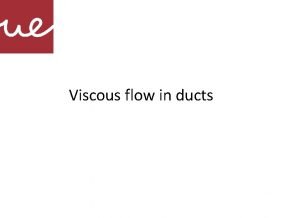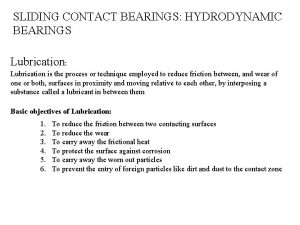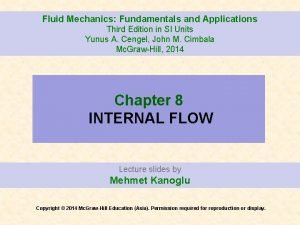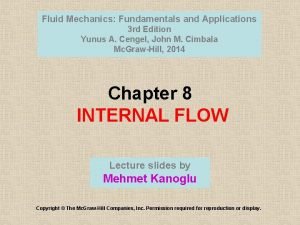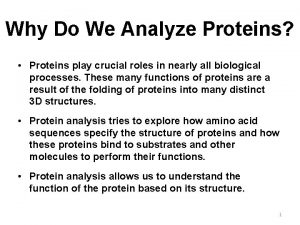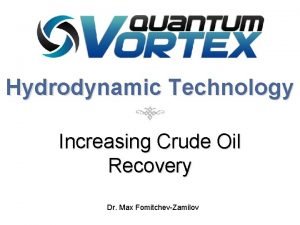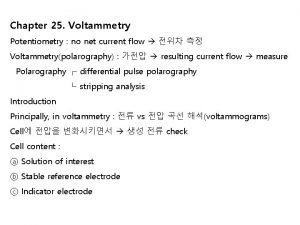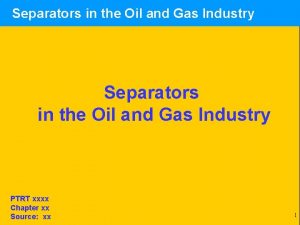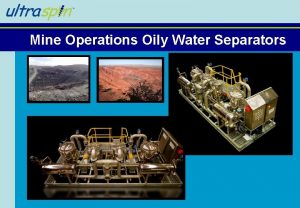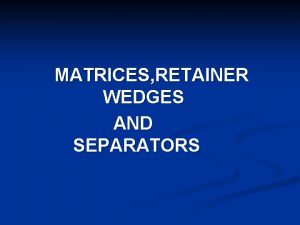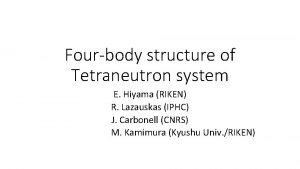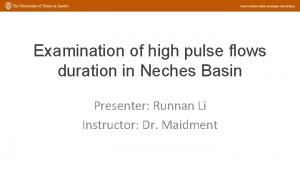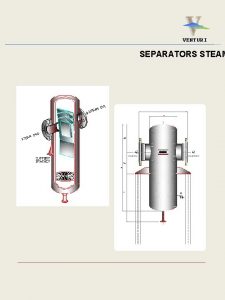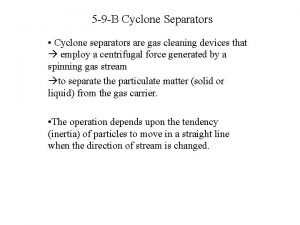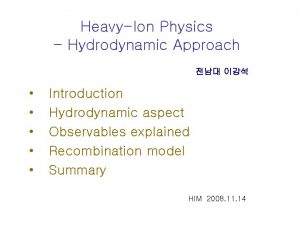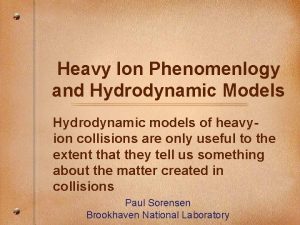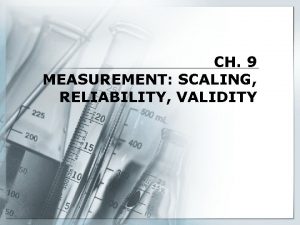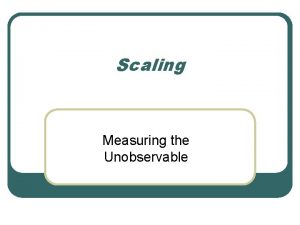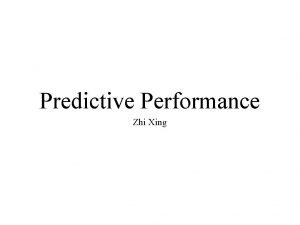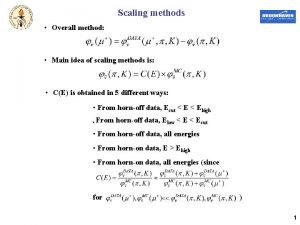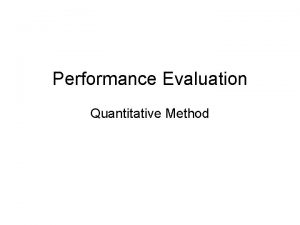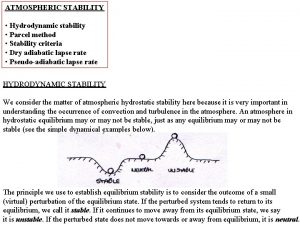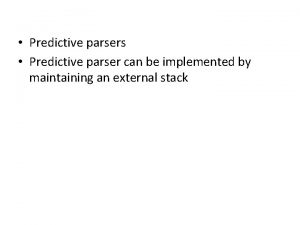Predictive Performance Scaling Method for Hydrodynamic Separators Mark












































- Slides: 44

Predictive Performance Scaling Method for Hydrodynamic Separators Mark B. Miller, P. G. Research Scientist mmiller@aquashieldinc. com Chattanooga, Tennessee (888) 344 -9044 EPA Region 6 MS 4 Stormwater Conference July 27 – August 1, 2014 Ft. Worth, Texas

? How do I predict an HDS performance curve for a different particle size than the performance curve derived from using the HDS’s lab test sediment’s particle size distribution? GET OUT YOUR SLIDE RULE… OR YOUR TI-30.

Topics of Discussion Ø Overview of Hydrodynamic Separators (HDSs) Ø The Problem: Evaluating Lab Performance Tests Ø A Solution: Performance Prediction Method Ø Calculations, Tables & Graphs Ø Example Comparison of HDS #1 to HDS #2 Ø Texas DOT Specification Example for 70% annual TSS removal and d 50 = 75 µm for 38 -500 µm PSD

Reference

Derivation of Peclet Number

Some Examples of Hydrodynamic Separators

Types of Hydrodynamic Separators Captures sediment, debris, free-floating oil, floatables Vortex type = Vault type = Gravitational & Centrifugal Forces Gravitational Forces

LID Technology Selection Pyramid

Hydrodynamic Separator Applications Pretreatment or Standalone On-line Off-line

HDS Verifications and Use Level Designations “TARP” (New Jersey) Technology Acceptance Reciprocity Partnership Protocol for Stormwater BMP Demonstrations Ø New Jersey DEP Lab Test Protocol for HDSs 1/25/13 now applies, no field test req’d Ø NJ PSD 1 -1, 000 µm, Scour test 50 -1, 000 µm for on-line HDS Ø NJDEP Certification for HDSs limited to 50% TSS removal credit regardless if higher rate achieved in lab or field test Ø Field test per TARP Tier II 2003/2006 NJDEP 2009 protocol expires w/ new lab test Ø Sizing based on MTFR for net annual TSS removal “TAPE” (Washington) Technology Assessment Protocol – Ecology Ø Use Level Designations GULD and CULD require field test in Pacific NW, lab data may supplement Ø PULD based on lab test Ø Influent TSS <100 mg/L, Effluent <20 mg/L Ø Influent TSS 100 -200 mg/L, Effluent ≥ 80% removal Ø Influent TSS >200 mg/L, Effluent >80% removal Ø ULDs for Dissolved Metals (Cu, Zn), Total Phosphorus, Oil (TPH), Pretreatment for TSS Ø Sizing based on 80% TSS removal per storm event

Evaluating HDS Laboratory Performance Testing We’ll explore NJCAT Lab Test Verifications and try to reduce the level of FRUSTRATION you may have when evaluating reports and results

HDS Lab Performance Curves from NJCAT Verification Reports* 100 90 TSS Removal Efficiency (%) 80 70 60 50 40 30 20 10 0 0 10 20 30 40 50 Loading Rate (gpm/sqft) 60 * Author does not guarantee accuracy of report interpretations 70 80

HDS Particle Size Distributions for NJCAT 100 90 80 70 % Finer 60 50 40 30 20 10 0 1 10 Particle Size (microns) * NJDEP 1/25/13 lab protocol d 50 <75 µm 100 1, 000

Steps for Predictive Performance Method 1. Calculate: Pe = (d · h · Vs) / Q using lab test data 2. 3. 4. 5. 6. Solve for: Q = (d · h · Vs) / Pe Convert Q to surface area loading rate (gpm/ft 2) Make table for RE% vs. Loading Rate Plot performance curve for selected particles size Make sizing chart(s) for: a) per storm TSS removal, or b) annual TSS removal

Peclet Number can be used to predict performance between different particle sizes “Peclet Number is defined as the ratio of advection to diffusion, where advective settling forces are opposed by turbulent diffusion in the system tending to keep solids in suspension. ” (SAFL) Pe = advection diffusion

Peclet Number (Pe) Pe = (d · h · Vs) / Q Pe = Unitless d = Horizontal flow dimension in feet h = Vertical flow dimension in feet Vs = Particle settling velocity in feet/sec Q = Flow rate in cubic feet/second • d in Vortex HDS = diameter of effective treatment area • d in Vault HDS = long axis of effective treatment area (parallel to flow)

Three Assumptions for Peclet Number (SAFL): 1. Settling Velocity assumes equivalent spherical particle shapes. 2. Mixing dynamics, and associated removal efficiency, scales with size (diameter and depth) for each device. 3. Turbulent diffusion coefficient (Dt) scales with Q/d across the range of tested flow rates.

Method Variables & Assumptions 1. Stoke’s Law for particle settling velocity using: a) Specific gravity = 2. 65 b) Water temperature 20°C (68°F) c) Other constant variables for Vs calculation 2. 100% TSS Removal Efficiency @ Zero Loading Rate 3. Calculations based on median (d 50) particle size, not full particle size distribution 4. Performance curve profile does not change for different d 50 simulations, but expected to change more as d 50 decreases below ~ 50 µm (presently undefined).

Calculate Pe: HDS #1 Test Parameters Q (cfs) Loading Rate (gpm/ft²) RE (%) Pe (unitless) d 50 = 110 µm (OK-110) 0 0 100 NA Vs = 0. 021 ft/s 0. 20 10. 8 89 1. 33 SG = 2. 65 0. 50 27. 1 82 0. 53 D = 3. 3 ft 0. 80 43. 3 57 0. 33 h = 3. 83 ft 1. 20 64. 9 18 0. 22 Pe = (d · h · Vs) / Q Example: Q = 0. 2 cfs Pe = (3. 3 ft · 3. 83 ft · 0. 021 ft/sec) / 0. 2 cfs = 1. 33

HDS #1 Performance Curve 100 TSS Removal Efficiency (%) 90 80 70 60 50 40 30 20 10 0 0 10 20 30 40 Loading Rate (gpm/sqft) 50 60 70

Calculate Particle Settling Velocity (Vs) Term Gs ρs ρw g T T μ υ D Vs Vs Vs Variable 2. 65 165. 07 62. 29 32. 20 20. 00 68 2. 09 E-05 1. 08 E-05 110 0. 024 0. 02080 0. 029 Input Value Units Description Specific gravity of particle lb/ft 3 Density of water ft/s 2 Acceleration due to gravity C° Temperature of water F° Temperature of water lb*s/ft 2 Dynamic viscosity of water at given temp. ft 2/s Kinematic Viscosity of water micron Diameter of particle ft/s Settling velocity, Cheng Formula ft/s Settling velocity, Stoke's Law ft/s Settling velocity, Ferguson & Church

Stoke’s Law Particle Settling Velocities Particle Size (µm) 45 50 67 75 90 110 125 Vs (ft/sec) 0. 0085 0. 010 0. 013 0. 014 0. 017 0. 021 0. 024

Performance Summary - 45 µm Rearrange equation to solve for Q Q = (3. 3 ft · 3. 83 ft · Vs) / Pe RE and Pe constant Parameters Q (cfs) Loading Rate (gpm/ft²) RE (%) Pe (unitless) d 50 = 45 µm 0 0 100 NA Vs = 0. 0085 ft/sec 0. 081 4. 4 89 1. 33 SG = 2. 65 0. 202 10. 9 82 0. 53 d = 3. 3 ft (8. 3 ft 2) 0. 325 17. 5 57 0. 33 h = 3. 83 ft 0. 486 26. 3 18 0. 22 Loading Rate = Q cfs · 448. 83 gpm/cfs / Area ft 2

HDS Performance Curves for 45 and 110 µm 100 TSS Removal Efficiency (%) 90 80 70 60 50 40 30 20 10 110µm 45µm 0 0 10 20 30 40 Loading Rate (gpm/sqft) 50 60 70

Parameters d 50 = 50 µm Vs = 0. 010 ft/sec SG = 2. 65 D = 3. 3 ft h = 3. 83 ft Q (cfs) 0 0. 10 0. 24 0. 38 0. 57 50 µm Loading Rate (gpm/ft²) 0 5. 2 12. 9 20. 6 30. 9 67 µm (d 50 from NJDEP PSD) Q Loading Rate Parameters (cfs) (gpm/ft²) d 50 = 67 µm 0 0 Vs = 0. 0. 013 ft/sec 0. 124 6. 7 SG = 2. 65 0. 310 16. 7 D = 3. 3 ft 0. 495 26. 8 h = 3. 83 ft 0. 743 40. 2 RE (%) 100 89 82 57 18 Pe (unitless) NA 1. 33 0. 53 0. 33 0. 22

Parameters d 50 = 75 µm Vs = 0. 014 ft/sec SG = 2. 65 D = 3. 3 ft h = 3. 83 ft Parameters d 50 = 90 µm Vs = 0. 017 ft/sec SG = 2. 65 D = 3. 3 ft h = 3. 83 ft Q (cfs) 0 0. 133 0. 333 0. 533 0. 800 75 µm Loading Rate (gpm/ft²) 0 7. 2 18. 0 28. 9 43. 3 RE (%) 100 89 82 57 18 Pe (unitless) NA 1. 33 0. 53 0. 33 0. 22 Q (cfs) 0 0. 162 0. 405 0. 648 0. 971 90 µm Loading Rate (gpm/ft²) 0 8. 8 21. 9 35. 0 52. 6 RE (%) 100 89 82 57 18 Pe (unitless) NA 1. 33 0. 53 0. 33 0. 22

Parameters d 50 = 110 µm Vs = 0. 021 ft/sec SG = 2. 65 D = 3. 3 ft h = 3. 83 ft Parameters d 50 = 125 µm Vs = 0. 024 ft/sec SG = 2. 65 D = 3. 3 ft h = 3. 83 ft 110 µm (lab test) Q Loading Rate (cfs) (gpm/ft²) 0 0 0. 2 10. 8 0. 5 27. 1 0. 8 43. 3 1. 2 64. 9 Q (cfs) 0 0. 229 0. 571 0. 914 1. 371 125 µm Loading Rate (gpm/ft²) 0 12. 4 30. 9 49. 5 74. 2 RE (%) 100 89 82 57 18 Pe (unitless) NA 1. 33 0. 53 0. 33 0. 22

HDS #1 Performance Summary 45 µm 50 µm 67 µm 75 µm 90 µm 110 µm 125 µm RE (%) LR gpm/ft 2 RE (%) LR gpm/ft 2 89 4. 4 89 5. 2 89 6. 7 89 7. 2 89 8. 8 89 10. 8 89 12. 4 82 10. 9 82 12. 9 82 16. 7 82 18. 0 82 21. 9 82 27. 1 82 30. 9 57 17. 5 57 20. 6 57 26. 8 57 28. 9 57 35. 0 57 43. 3 57 49. 5 18 26. 3 18 30. 9 18 40. 2 18 43. 3 18 52. 6 18 64. 9 18 74. 2 Note: Removal efficiencies are constant for each particle size

HDS #1 Performance Curves for Different Particle Sizes 100 90 TSS Removal Efficiency (%) 80 70 60 50 40 30 20 45µm 10 50µm 67µm 75µm 90µm 110µm 125µm 0 0 10 20 30 40 Loading Rate (gpm/sqft) 50 60 70 80

HDS Comparison: Lab Test PSDs 100 90 80 HDS #1 70 HDS #2 % Finer 60 50 40 30 20 10 0 1 10 Particle Size (microns) * NJDEP 1/25/13 lab protocol d 50 <75 µm 100 1, 000

HDS #2 Performance HDS #2: 63 µm Lab Test (Calculate Pe) Q Loading Rate RE Parameters (cfs) (gpm/ft²) (%) d 50 = 63 µm 0 0 100 Vs = 0. 013 ft/sec 0. 27 6. 4 85 SG = 2. 65 0. 55 12. 8 82 D = 5 ft (19. 6 ft 2) 0. 83 19. 1 80. 2 h = 2. 6 ft 1. 1 25. 5 79 Pe (unitless) NA 0. 69 0. 34 0. 23 0. 17 HDS #2: Q @ 110 µm by Peclet Method Q Loading Rate RE Parameters (cfs) (gpm/ft²) (%) d 50 = 110 µm 0 0 100 Vs = 0. 021 ft/sec 0. 448 11. 0 85 SG = 2. 65 0. 96 22. 0 82 D = 5 ft (19. 6 ft 2) 1. 43 32. 7 80. 2 h = 2. 6 ft 1. 93 44. 2 79 Pe (unitless) NA 0. 69 0. 34 0. 23 0. 17

Parameters d 50 = 110 µm Vs = 0. 021 ft/sec SG = 2. 65 D = 3. 3 ft (8. 3 ft 2) h = 3. 83 ft HDS #1: 110 µm Lab Test Q Loading Rate (cfs) (gpm/ft²) 0 0 0. 2 10. 8 0. 5 27. 1 0. 8 43. 3 1. 2 64. 9 RE (%) 100 89 82 57 18 HDS #1: Q @ 63 µm by Peclet Method Q Loading Rate RE Parameters (cfs) (gpm/ft²) (%) d 50 = 63 µm 0 0 100 Vs = 0. 013 ft/sec 0. 12 6. 5 89 SG = 2. 65 0. 31 16. 8 82 D = 3. 3 ft (8. 3 ft 2) 0. 50 27. 0 57 h = 3. 83 ft 0. 75 40. 6 18 Pe (unitless) NA 1. 33 0. 53 0. 33 0. 22

HDS #1 and HDS #2 Performance Curves 100 90 HDS #2 110µm TSS Removal Efficiency (%) 80 HDS #2 63µm lab test 70 60 50 40 30 20 HDS #1 63µm 10 HDS #1 110µm lab test 0 0 10 ACME 63 micron 20 30 40 Loading Rate (gpm/sqft) ACME 110 micron HDS 110 micron 50 60 HDS 63 micron 70

HDS #1: 80% TSS Removal Per Storm 100 TSS Removal Efficiency (%) 90 80% TSS Removal Per Storm 80 70 60 50 40 30 20 45µm 50µm 10 67µm 75µm 90µm 110µm 125µm 0 0 10 20 30 40 50 Loading Rate (gpm/sqft) 60 70 80

HDS #1 Particle Size and Peak Loading Rate for 80% TSS Removal Efficiency Per Storm Particle Size (µm) Peak Loading Rate (gpm/ft 2)* 45 50 67 75 90 110 125 10. 5 12. 2 16. 0 17. 5 21. 0 26. 0* 30. 0 * Exact Loading Rate can be calculated using equation for slope of performance curve

Example HDS #1 Sizing Charts: 80% TSS Removal per Storm Particle Size and Loading Rate 45 µm 50 µm 67 µm 75 µm 90 µm 110 µm 125 µm 10. 5 gpm/ft 2 12. 2 gpm/ft 2 16. 0 gpm/ft 2 17. 5 gpm/ft 2 21. 0 gpm/ft 2 26. 0 gpm/ft 2 30. 0 gpm/ft 2 WQTF (cfs) WQTF (cfs) 4. 9 0. 11 0. 13 0. 17 0. 19 0. 23 0. 28 0. 33 5. 0 19. 6 0. 46 0. 53 0. 70 0. 76 0. 92 1. 14 1. 31 6. 0 28. 3 0. 66 0. 77 1. 01 1. 10 1. 32 1. 64 1. 89 8. 0 50. 3 1. 18 1. 37 1. 79 1. 96 2. 35 2. 91 3. 36 10. 0 78. 5 1. 84 2. 13 2. 80 3. 06 3. 67 4. 54 5. 24 Example HDS Model Diameter (ft) Effective Treatment Area (ft 2) 2. 5 Water Quality Treatment Flow = (Area · Loading Rate) / 448. 83 gpm/cfs Example: WQTF @ 1. 4 cfs for 75 µm = HDS Model 8 ft diameter

Special Specification 5848 “The SWTU shall be capable of removing at least 70% of the net annual Total Suspended Solids (TSS) based on a typical gradation of 38 -500 microns with a d 50 -micron particle size of 75; remove particles greater than 150 –microns (sand-size particles); capture and retain 100% of pollutants greater than 1 inch in size based on the objects smallest dimension; and capture and retain total petroleum hydrocarbons. ”

Texas DOT Particle Size Distribution 38 -500 µm 100 90 80 % Finer 70 60 50 40 30 20 10 0 1 10 100 Particle Size (microns) Texas DOT PSD NJDEP (new) 1, 000

75 µm TXDOT Specification - HDS #1 Q 75 (cfs) Loading Rate (gpm/ft 2) RE (%) Given Q 110 µm Q 75/Q 110 (cfs) Pe 0 0 100 NA 0 0. 133 7. 2 89 1. 33 0. 2 0. 133/0. 2 66. 5 0. 333 18. 0 82 0. 53 0. 5 0. 333/0. 5 66. 6 0. 533 28. 9 57 0. 33 0. 8 0. 533/0. 8 66. 6 0. 800 43. 3 18 0. 22 1. 2 0. 8/1. 2 66. 7 % Flow 75 µm/110 µm v HDS lab test showed 80% net annual TSS removal up to 100 gpm/ft 2. v Make sizing chart based on peak flow, 66. 6% of 100 gpm/ft 2, or 66. 6 gpm/ft 2

HDS #1 Performance Curves for 75 µm and 110 µm 100 TSS Removal Efficiency (%) 90 80 70 60 50 40 30 20 80% net annual TSS removal @ 100 gpm/ft 2 10 75µm 110µm 0 0 10 20 30 40 Loading Rate (gpm/sqft) 50 60 70

TXDOT HDS Sizing Chart for HDS #1 80%* Annual TSS Removal for 75 µm * Exceeds specification of 70% annual TSS removal HDS Model Diameter (ft) Treatment Area (ft 2) Water Quality Treatment Flow @ 66. 7 gpm/ft 2 (cfs) 2. 5 4. 9 0. 73 5. 0 19. 6 2. 92 6. 0 28. 3 4. 20 8. 0 50. 3 7. 47 10. 0 78. 5 11. 67 WQTF = (Treatment Area · Loading Rate) / gpm/cfs WQTF = (X. X ft 2 · 66. 7 gpm/ft 2) / 448. 83 gpm/cfs

Here’s the steps to follow: 1. Calculate: Pe = (d · h · Vs) / Q using lab test data 2. 3. 4. 5. 6. Solve for: Q = (d · h · Vs) / Pe Convert Q to surface area loading rate (gpm/ft 2) Make table for RE% vs. Loading Rate Plot performance curve for selected particles size Make sizing chart(s) for: a) per storm TSS removal efficiency, or b) annual TSS removal efficiency 7. Brag to boss how you solved a mystery of stormwater life


Mark Miller mmiller@aquashieldinc. com
 Hydrodynamic entry length formula
Hydrodynamic entry length formula Hydrodynamic lubrication
Hydrodynamic lubrication Hydraulic diameter formula
Hydraulic diameter formula Laminar flow
Laminar flow Hydrodynamic escape
Hydrodynamic escape Hydrodynamic radius
Hydrodynamic radius Acoust oil max
Acoust oil max Hydrodynamic voltammetry
Hydrodynamic voltammetry Types of separators in oil and gas industry
Types of separators in oil and gas industry Mining oil separators
Mining oil separators Matrices and wedges
Matrices and wedges Chapter 26 review questions milady
Chapter 26 review questions milady Window pane separators
Window pane separators Types of separators in oil and gas industry
Types of separators in oil and gas industry Scaling method
Scaling method Scaling method
Scaling method Symposium introduction
Symposium introduction Kontinuitetshantering
Kontinuitetshantering Novell typiska drag
Novell typiska drag Nationell inriktning för artificiell intelligens
Nationell inriktning för artificiell intelligens Vad står k.r.å.k.a.n för
Vad står k.r.å.k.a.n för Varför kallas perioden 1918-1939 för mellankrigstiden?
Varför kallas perioden 1918-1939 för mellankrigstiden? En lathund för arbete med kontinuitetshantering
En lathund för arbete med kontinuitetshantering Särskild löneskatt för pensionskostnader
Särskild löneskatt för pensionskostnader Tidbok
Tidbok Anatomi organ reproduksi
Anatomi organ reproduksi Förklara densitet för barn
Förklara densitet för barn Datorkunskap för nybörjare
Datorkunskap för nybörjare Boverket ka
Boverket ka Mall för debattartikel
Mall för debattartikel Autokratiskt ledarskap
Autokratiskt ledarskap Nyckelkompetenser för livslångt lärande
Nyckelkompetenser för livslångt lärande Påbyggnader för flakfordon
Påbyggnader för flakfordon Tryck formel
Tryck formel Publik sektor
Publik sektor Jag har gått inunder stjärnor text
Jag har gått inunder stjärnor text Presentera för publik crossboss
Presentera för publik crossboss Vad är ett minoritetsspråk
Vad är ett minoritetsspråk Plats för toran ark
Plats för toran ark Klassificeringsstruktur för kommunala verksamheter
Klassificeringsstruktur för kommunala verksamheter Luftstrupen för medicinare
Luftstrupen för medicinare Claes martinsson
Claes martinsson Centrum för kunskap och säkerhet
Centrum för kunskap och säkerhet Programskede byggprocessen
Programskede byggprocessen Bra mat för unga idrottare
Bra mat för unga idrottare
